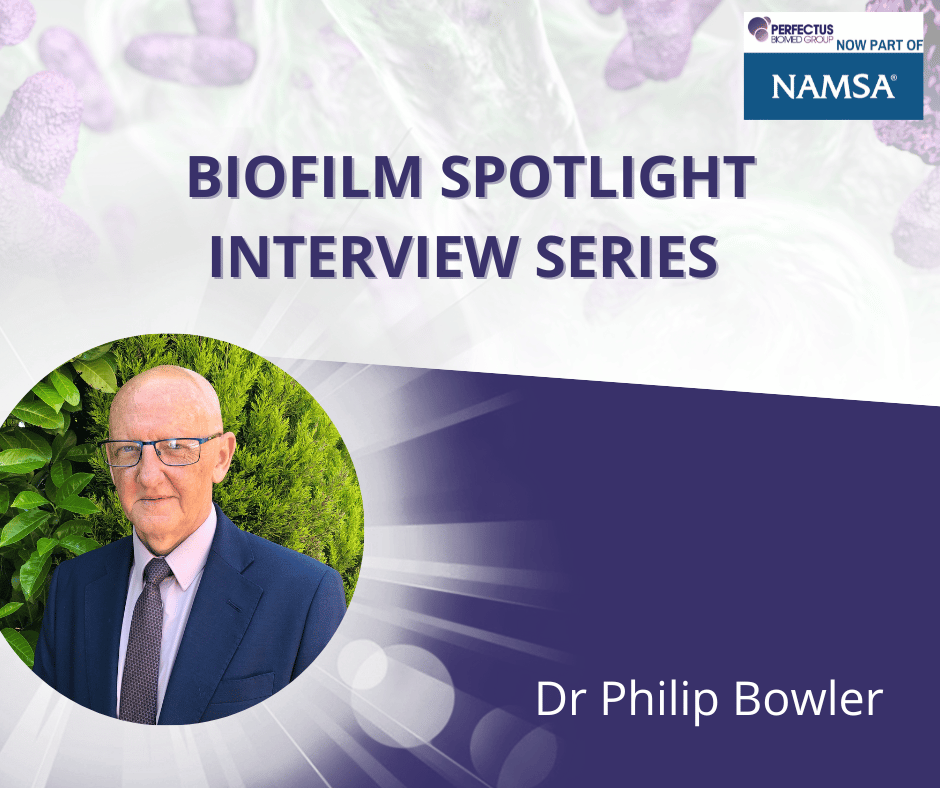We are once again supporting the NBIC Biofilm Week 2022 campaign, highlighting research to prevent, detect, manage, and engineer biofilms.
Perfectus Biomed Group, now part of NAMSA, are thrilled to take this opportunity to launch our Biofilm Spotlight Interview Series. An exclusive conversation with some key opinion leaders in the biofilm space, discussing the expansive global and economic and physical impact of biofilms. Dr Philip Bowler, an expert scientist in biofilms, chronic infections, infection prevention, and medical devices, is our first Biofilm Spotlight speaker.
Hi Phil, thank you for taking part in our biofilm spotlight series, can you briefly explain what are biofilms?
Biofilms are microbial (predominantly bacterial) communities encased within a self-produced extracellular matrix that provides protection from external hostilities such as heat, aridity, antibiotics, biocides, and inflammatory activity.
NBIC #BiofilmWeek is coinciding with World Antimicrobial Awareness Week, how are biofilms associated with antimicrobial resistance?
Although the global health concerns associated with antimicrobial resistance (AMR) are widely acknowledged, less is known about the involvement of biofilm in AMR. The biofilm matrix provides an ideal environment for horizontal transfer of genes between bacteria, including the transmission of antibiotic resistance genes. Biofilm can therefore exacerbate antibiotic resistance and contribute significantly to the global threat. Consequently, there is a critical need to consider new antimicrobial strategies and therapies that can facilitate disruption of biofilm, thereby enhancing the efficacy of antimicrobial agents, and also reducing the opportunity for antibiotic resistance gene transfer within biofilm.
How common are biofilms in chronic wounds and why are biofilms problematic for wound healing?
Studies have reported that approximately 80% of chronic, hard-to-heal wounds contain biofilm. However, since biofilm is the primary cause of delayed or stalled healing, it is likely that any wound that is not healing and is unresponsive to antimicrobial agents is biofilm-impeded.
Focusing on anti-biofilm strategies, can you describe the importance of antimicrobial (killing of the biofilm-related organisms) versus physical removal of the biofilm? Why are both important?
Biofilm protects associated bacteria from antimicrobial agents such as antibiotics and antiseptics. Consequently, additional strategies are required aimed at biofilm dispersal to expose associated bacteria (i.e., transforming them from biofilm to planktonic forms), making them more susceptible to antimicrobial agents. Physical disruption using debridement techniques, together with wound cleansing solutions containing surfactant, can help to disperse biofilm, and enable antimicrobial agents to work more effectively. Consequently, a combined anti-biofilm / antimicrobial strategy is important.
Why do you think testing new antimicrobial wound dressings for their anti-biofilm properties is important?
Bacteria naturally exist in their highly tolerant biofilm form in human infections, and consequently testing the efficacy of antimicrobial agents in the laboratory should be undertaken using stringent biofilm models.
Samples taken from recalcitrant biofilm infections (e.g., chronic wounds) that are frequently unresponsive to antimicrobial therapy, often grow bacteria that are susceptible to antimicrobial agents when tested in the laboratory using conventional microbiology methods (e.g., agar plates and broths). This is because bacteria in the biofilm state in situ revert to planktonic forms when grown in the laboratory using conventional microbiology methods; bacteria don’t need to produce protective biofilm when they are grown in non-hostile, highly nutritious laboratory conditions. Consequently, testing of antimicrobial agents must be performed using biofilm models that more accurately simulate clinical conditions, and determine true susceptibility profiles.
Thank you, Phil, for a very insightful discussion. A fantastic start to our biofilm spotlight interview series.
Perfectus scientists are sector leaders in the customization and adaptation of in vitro and ex vivo biofilm studies. Accredited test methods include MBEC, CDC Biofilm Reactor, Drip Flow Biofilm Reactor, Single Tube Method, Ex Vivo Porcine Lung Model, and Ex Vivo Burn Wound Model. We will work with you to help you understand the benefits of different biofilm testing models and then choose a test method that is most suitable for your product. Our data is globally recognized by regulatory bodies and can be carried out to GLP as requested. For more information about the types of biofilm testing Perfectus Biomed can offer, contact our experts at info@perfectusbiomed.com or call +44 (0) 1925 737237.
Bio: Phil Bowler is the owner and scientific advisor at Phil Bowler Consulting Ltd, a company which he established in August 2020 following a 32-year career at the medtech company, Convatec, where he was the VP of Science & Technology. In his role at Convatec, Phil played a lead role in the science behind chronic conditions, innovation, and the development of Convatec’s innovative antimicrobial wound dressings. Phil received his BSc degree from The University of Salford in 1979, and his MPhil degree from the University of Wales College of Medicine, Cardiff in 1999. Phil is recognized internationally for his knowledge and work in the fields of chronic infections, biofilm, wound microbiology, infection prevention, antimicrobial therapies, and antibiotic resistance. He has published widely, and he has also been an invited speaker at numerous international conferences.

